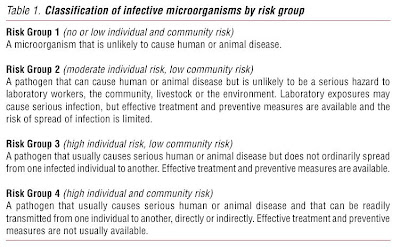For Microbiology Laboratory, the facilities need to consider Biosafety Levels. WHO identified Risk Groups into 1, 2, 3 and 4. The table 1 is a classification of infective microorganisms by risk group.
 Table 2 is relation of risk groups to biosafety levels, practices and equipment
Table 2 is relation of risk groups to biosafety levels, practices and equipment1. The international biohazard warning symbol and sign (Figure 1) must be displayed on the doors of the rooms where microorganisms of Risk Group 2 or higher risk groups are handled.
2. Only authorized persons should be allowed to enter the laboratory working areas.
3. Laboratory doors should be kept closed.
4. Children should not be authorized or allowed to enter laboratory working areas.
5. Access to animal houses should be specially authorized.
6. No animals should be admitted other than those involved in the work of the laboratory.
Fig 1. Biohazard warning sign for laboratory doors

Laboratory design and facilities for BSL 1 & 2.
1. Formation of aerosols
2. Work with large volumes and/or high concentrations of microorganisms
3. Overcrowding and too much equipment
4. Infestation with rodents and arthropods
5. Unauthorized entrance
6. Workflow: use of specific samples and reagents.
Examples of laboratory designs for Biosafety Levels 1 and 2 are shown in Figures 2 and 3, respectively.
Fig. 2 A typical Biosafety Level 1 laboratory

The containment laboratory – Biosafety Level 3 is designed and provided for work
with Risk Group 3 microorganisms and with large volumes or high concentrations of
Risk Group 2 microorganisms that pose an increased risk of aerosol spread.
Fig. 4 A typical Biosafety Level 3 laboratory
 The maximum containment laboratory – Biosafety Level 4 is designed for work withRisk Group 4 microorganisms. (It is not allowed in Hong Kong.)
The maximum containment laboratory – Biosafety Level 4 is designed for work withRisk Group 4 microorganisms. (It is not allowed in Hong Kong.)For Molecular Biology Laboratory, the requirement to set up a PCR Laboratory is considered.
Development of the polymerase chain reaction (PCR) as a basic component of the molecular biology laboratory. The PCR laboratory typically is involved with activities that include sample preparation, PCR reaction assembly, PCR execution, and post-PCR analysis. Contamination prevention approaches are used in the PCR laboratory.
Fig.5 Outline of sample processing and analysis in a PCR laboratory.

Air handling:
In the pre-PCR laboratory, there should be a slight positive pressure compared to the air in the connecting hallway. The post-PCR laboratory, in contrast, should be at slightly reduced pressure to pull air in from the outside and thereby prevent escape of amplicons from the completed PCR samples being analyzed inside the lab
UV irradiation:
It uses UV to sterilize the entire pre-PCR laboratory.
Protective clothing:
To further prevent PCR amplicons from leaving the post-PCR lab, each investigator should have a dedicated post-PCR lab coat. Additionally, each investigator should have a general molecular biology lab coat and a separate coat for pre-PCR.
Adhesive paper at lab entrances:
This approach effectively prevents trace amounts of dust and debris from entering the laboratory.
Reference:
1. Laboratory biosafety manual (Third edition) 2004: By World Health Organization
2. Setting Up a PCR Laboratory: By Theodore E. Mifflin (Department of Pathology, University of Virginia, Charlottesville, Virginia 22908)




沒有留言:
發佈留言